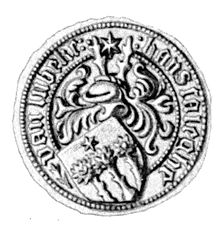Johann Salige
Johann Salige (* probably before 1485 in Lübeck ; † 1530 there ) was a merchant and councilor of the Hanseatic city of Lübeck.
Life
As the son of the Lübeck citizen and businessman Marquart Salige, Johann Salige married his wife Richel Brömse (around 1477–1517) in 1507 into the inner circle of the Lübeck patriciate. Her father was the mayor of Lübeck, Heinrich Brömse, who died in 1502 . Together with her parents and siblings, she is depicted on the side wing of the retable on the altar in the burial chapel in a south side chapel of the St. James' Church . Her daughter Elisabeth († 1569) was the abbess of the Johannis Monastery .
The merchant Salige had contacts in Upper Germany . A contract (1512) on the production of publishing products with a Nuremberg business partner is known. In 1518 Salige was elected to the Lübeck council . Socially he was a member of several brotherhoods , so since 1493 in the Antonius Brotherhood , in the Leonhard Brotherhood , the Corpse Brotherhood and the Rochus Brotherhood . In 1512 he bought the house at Königstrasse 33.
Benefactor
In Lübeck's history, Salige has primarily emerged as a founder.
Together with his father he donated four reliefs made by Heinrich Brabender from Baumberger sandstone with passion scenes for the choir screen (around 1510/12) in St. Marien with the pictures of the washing of feet, the Lord's Supper, the Mount of Olives and the capture. With the world-famous church mouse contained in the Last Supper relief, Brabender created one of Lübeck's landmarks . In the Jakobikirche, the relief in the middle section (Christ Erlöserwerk), such as the predella of the altar donated by Mayor Heinrich Brömse in the family chapel by Heinrich Brabender, continues to come from.
The date of erection of the rood screen of the Marienkirche coincides with his election to the council in 1518. His wife had died the year before. Together with the newly arrived merchant Godart Wigerinck († 1518), whose bronze tombstone by Peter Vischer from Nuremberg is still preserved today, he decorates the west side of the rood screen balustrade with sculptures of saints. Based on the family coats of arms of the founders and their wives, we know that Salige took over the northern side and Wigerinck the southern side. The wooden rood screen figures are awarded by both clients to the Lübeck carver Benedikt Dreyer , who also made the Antonius retable for the Antonius Brotherhood. These figures were burned in the air raid on Palm Sunday 1942 and are only documented photographically.
literature
- Emil Ferdinand Fehling : Lübeckische Ratslinie , Lübeck 1925, No. 606
- Tamara Thiesen: Benedikt Dreyer. Kiel 2007, pp. 69–147 (75 ff.) ISBN 978-3-937719-57-3
- Reinhard Karrenbrock: Four choir screen reliefs in: Jan Friedrich Richter (Ed.): Lübeck 1500 - Art metropolis in the Baltic Sea region , catalog, Imhoff, Petersberg 2015, pp. 268–271 (No. 35)
Web links
Individual evidence
- ↑ Klaus Krüger: Corpus of the medieval grave monuments in Lübeck, Schleswig, Holstein and Lauenburg 1100-1600 , Jan Thorbeke Verlag, Stuttgart 1999, p. 799 grave plate "LÜJO * 48" ISBN 3-7995-5940-X
- ↑ Königstrasse 22–59 (pdf, accessed December 20, 2014)
- ↑ Latin inscription text of the reliefs with explanation and translation by: Adolf Clasen : Verhabene Schätze - Lübeck's Latin inscriptions in the original and in German. Lübeck 2002, p. 34 ff. ISBN 3795004756
- ↑ Your touch should bring luck. You can see that in her. This mouse is the subject of a legend, see the digitized Die Maus in Wikisource .
- ↑ Johannes Baltzer , Friedrich Bruns: The architectural and art monuments of the Free and Hanseatic City of Lübeck . Issued by the building authorities. Volume III: Church of Old Lübeck. Dom. Jakobikirche. Aegidia Church . Verlag von Bernhard Nöhring, Lübeck 1920, pages 351 to 360. Unchanged reprint 2001: ISBN 3-89557-167-9 ; More recent views in art history assign the sandstone work on this altar to his companion Evert van Roden ; with regard to painting, reference is made to the master's participation from 1489 .
- ^ Heinrich Dormeier: Economic success, lay piety and art in Lübeck around 1500. The foundations of the banker and wholesale merchant Godert Wiggerinck . In: Enno Bünz / Klaus-Joachim Lorenzen-Schmidt (ed.): Clergy, Church and Piety in Late Medieval Schleswig-Holstein , Neumünster 2006, pp. 274–297
| personal data | |
|---|---|
| SURNAME | Salige, Johann |
| BRIEF DESCRIPTION | Merchant and councilor of the Hanseatic city of Lübeck |
| DATE OF BIRTH | before 1485 |
| PLACE OF BIRTH | Lübeck , Holy Roman Empire |
| DATE OF DEATH | 1530 |
| Place of death | Lübeck , Holy Roman Empire |

